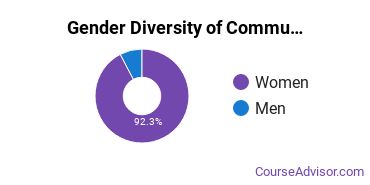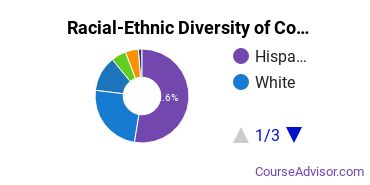Communication Sciences at California State University - Fullerton
Cal State Fullerton is located in Fullerton, California and has a total student population of 42,051.
Want to know more about the career opportunities in this field? Check out the Careers in Communication Sciences section at the bottom of this page.
Cal State Fullerton Communication Sciences Degrees Available
- Bachelor’s Degree in Communication Sciences
- Master’s Degree in Communication Sciences
Cal State Fullerton Communication Sciences Rankings
The communication sciences major at Cal State Fullerton is not ranked on College Factual’s Best Colleges and Universities for Communication Sciences. This could be for a number of reasons, such as not having enough data on the major or school to make an accurate assessment of its quality.
Communication Sciences Student Demographics at Cal State Fullerton
Take a look at the following statistics related to the make-up of the communication sciences majors at California State University - Fullerton.
Cal State Fullerton Communication Sciences Bachelor’s Program

Prospective students may be interested in knowing that this school graduates 43% more racial-ethnic minorities in its communication sciences bachelor's program than the national average.*
The following table and chart show the race/ethnicity for students who recently graduated from California State University - Fullerton with a bachelor's in communication sciences.

| Race/Ethnicity | Number of Students |
|---|---|
| Asian | 32 |
| Black or African American | 1 |
| Hispanic or Latino | 66 |
| White | 36 |
| International Students | 0 |
| Other Races/Ethnicities | 15 |
Cal State Fullerton Communication Sciences Master’s Program

In the communication sciences master's program at this school, racial-ethnic minorities make up 76% of degree recipients. That is 47% better than the national average.*
The following table and chart show the race/ethnicity for students who recently graduated from California State University - Fullerton with a master's in communication sciences.

| Race/Ethnicity | Number of Students |
|---|---|
| Asian | 10 |
| Black or African American | 1 |
| Hispanic or Latino | 14 |
| White | 7 |
| International Students | 1 |
| Other Races/Ethnicities | 1 |
Concentrations Within Communication Sciences
Communication Sciences majors may want to concentrate their studies in one of these areas. The table shows all degrees awarded in this field awarded for all degree levels at California State University - Fullerton. A concentration may not be available for your level.
| Concentration | Annual Degrees Awarded |
|---|---|
| General Communication Sciences & Disorders | 186 |
Related Majors
Careers That Communication Sciences Grads May Go Into
A degree in communication sciences can lead to the following careers. Since job numbers and average salaries can vary by geographic location, we have only included the numbers for CA, the home state for California State University - Fullerton.
| Occupation | Jobs in CA | Average Salary in CA |
|---|---|---|
| Speech-Language Pathologists | 13,220 | $93,510 |
| Health Specialties Professors | 11,540 | $161,770 |
| Audiologists | 990 | $100,960 |
References
*The racial-ethnic minorities count is calculated by taking the total number of students and subtracting white students, international students, and students whose race/ethnicity was unknown. This number is then divided by the total number of students at the school to obtain the racial-ethnic minorities percentage.
- College Factual
- National Center for Education Statistics
- O*NET Online
- Image Credit: By Bobak Ha’Eri under License
More about our data sources and methodologies.
